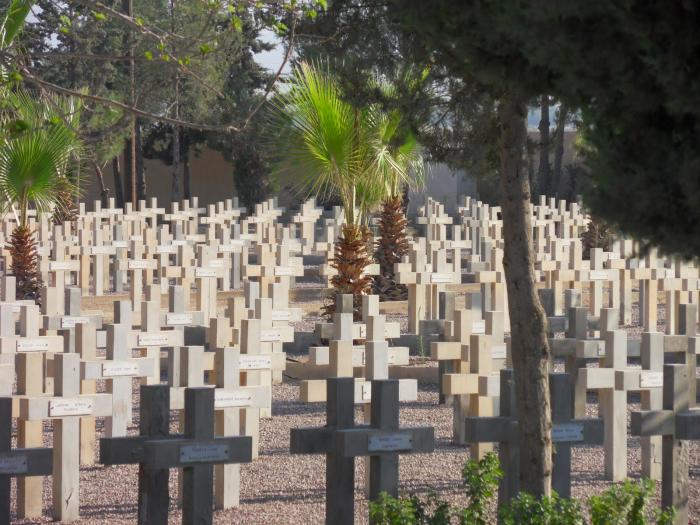French Military Cemetery in Dmeir

French Military Cemetery in Dmeir. Source: Photo by Jocelyn Trouslard
The Military Cemetery in Dmeir contains over 4,000 French and foreign military graves...
The French necropolis in Dmeir, Syria, was created in 1960 to gather the bodies of soldiers who died during the French mandate over the region and their brothers who fell in the Second World War.
Bearing witness to France’s history in the Middle East, the Military Cemetery in Dmeir, Syria, contains the graves of more than 4,000 French and foreign soldiers, whether Muslim or Christian, as well as a few civilian tombs. In 1920, the League of Nations entrusted mandates over Syria and Lebanon to France after the defeat of the Ottoman Empire during the First World War (Treaty of Sèvres and the Sykes-Picot Agreement).
The French mandate over Syria was organised into four States: the Sanjaks of Damascus and Aleppo, the Alawite State (1920), and the Jabal Druze State (1921). Clashes (intervention in Cilicia) due to tribal rivalries and opposition to the French presence led to the dissociation of the Sanjak of Alexandrette and the Sanjak of Aleppo in March of 1923. General Gouraud founded the Syrian Federation made up of Damascus, Aleppo and the Alawite State – dismantled in 1924.
From 1925 to 1927, General Sarrail was in charge of restoring order in the Jabal Druze.
The Second World War delayed the Syrian independence called for by the Viénot accords (1936). In 1940, the Vichy regime appointed a new high commissioner, General Dentz. He carried out a policy of neutrality toward the United Kingdom, while allowing German aircraft to transit through Syrian airports to support the revolt in Iraq in 1941.
A German garrison moved into the airport at Neirab, giving rise to resistance by the Franco-British forces. The Germans were pushed back, with the help of Syrian troops, and independence was proclaimed by Free France in 1941: General Catroux had promised independence to the States under the mandate. This was achieved at the end of the war.
The last French troops left the region in 1946. At the time, the tombs of French soldiers who had died in 1914-1918, 1920-1921, 1924-1925 and 1939-1945 were located in five main necropolises: Mezzeh, Aleppo, Lattaquieh, Deir-ez-Zor and Tartus.
Between 1985 and 1998, the necropolis was expanded with the transfer of the tombs in Lattaquieh and Aleppo.
In the 1950s, the decision was taken to group them together at a single site. Some 16,000 m² of land was chosen on the road leading from Damascus to Baghdad, 35 km from the Syrian capital. The bodies began to be gathered at the site in 1960 with the transfer of tombs from the cemetery in Mezzeh, in a rapidly expanding suburb of Damascus, and progressively continued, being completed in 1998 with the closing of the cemetery in Aleppo.
Located on the Route de Palmyre, this memorial site is particularly visited by French tourists. Each year on 11 November, a commemorative Franco-Syrian ceremony is held in memory of this shared history.
French Embassy in Syria
Rue Ata-al-Ayyoubi POB 769 - Damascus
Tel.: (963) 11 332 79 92
Fax: (963) 11 331 06 44
e-mail: ambassade@ambafrance-sy.org
Website: www.ambafrance-sy.org
Access
The necropolis is open to the public every day (except Sundays)
Practical information
32144
Dumayr
Tél. : (963) 11 332 79 92Fax : (963) 11 331 06 44
Year-round accessibility

